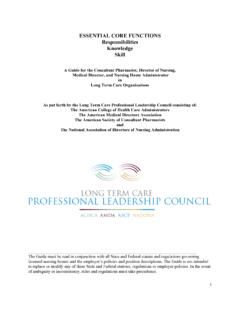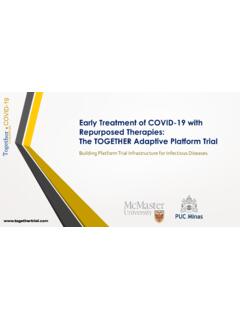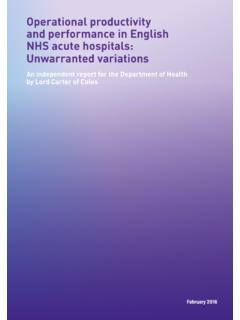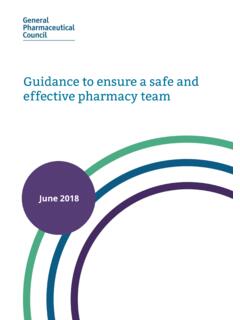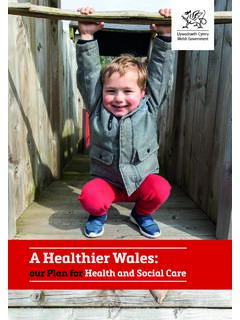Transcription of Evaluation of nurse and pharmacist independent prescribing
1 Evaluation of nurse and pharmacist independent prescribingSue LatterAlison BlenkinsoppAlesha SmithSteve ChapmanMichela TinelliKaren GerardPaul LittleNicola CelinoTrudy GranbyPeter NichollsGill DorerDepartment of Health Policy Research Programme Project 016 0108 University of Southampton Keele UniversitySubmitted October 2010 iAcknowledgementsWe would like to thank the following contributors: Deborah Fenlon (literature searching and review)Robert Hallworth (non-medical prescribing leads survey piloting and data collection)Andrew Sibley (non-medical prescribing leads survey additional data analysis, data collection at case sites)Amanda Lees (data entry, analysis of prescribing clinical appropriateness)Nick Thayer and Bernard Naughton (data entry, patient experience survey) Phil Woodvine (electronic data collection templates, case record audit)Luke Bracegirdle (support for electronic data entry)
2 Barbara Sandland co-ordinated the HEI focus groups and multi-stakeholder would also like to thank the nurse and pharmacist independent prescribers, non-medical prescribing Strategic Health Authority and Trust leads, HEI non-medical prescribing programme leads, Designated Medical Practitioners, the raters who helped analyse prescribing appropriateness, and the patients and stakeholder workshop participants who took part in our thank the Nursing and Midwifery Council and the Royal Pharmaceutical Society of Great Britain for assistance with the survey of nurse and pharmacist Paul Bissell and Dr Derek Stewart gave us permission to use some questions from their surveys of patients of nurse and pharmacist prescribers.
3 The team are also sincerely grateful for the advice and contribution of the study Advisory is an independent report commissioned and funded by the Policy Research Programme in the Department of Health. The views expressed are not necessarily those of the Department. 11 Executive Summary of Key Points Between 2% and 3% of both the nursing and pharmacist workforce are qualified to prescribe medicines independently 93% of nurse prescribers and 80% of pharmacist prescribers had used their independent prescribing qualification. 86% of the nurses and 71% of the pharmacists were currently prescribing1 Nurses and pharmacists are prescribing predominantly in primary care, with substantial numbers also in secondary care settings Study results indicate that overall, nurse and pharmacist prescribing is currently safe and clinically appropriate The study findings indicate that current educational programmes of preparation for nurse and pharmacist prescribing are operating largely satisfactorily.
4 And provide fit-for-purpose preparation Evidence suggests that non-medical prescribing has been largely driven by individual practitioners to date, and has been used to increase the quality of existing services, as opposed to enabling service re-design Only about half of Trusts reported a strategy or written plan for the development of non-medical prescribing Key clinical governance and risk management strategies for non-medical prescribing are in place within the majority of Trusts Acceptability of independent prescribing to patients is high, as evidenced by the majority of patients reporting that they were very satisfied with their visit to their nurse or pharmacist prescriber When comparing care provided by their nurse or pharmacist independent prescriber to being treated by their GP.
5 Most patients in this study did not report a strong preference for either their non-medical or medical prescriber Results indicate that non-medical prescribing was generally viewed positively by other health care professionals nurse and pharmacist independent prescribing in England is becoming a well integrated and established means of managing a patient s condition and giving him/her access to medicines Key issues for further expansion of non-medical prescribing may include preparing nurses and pharmacists to prescribe across conditions for patients with co-morbidities1 The survey was conducted in autumn 2008 when there were 358 pharmacist independent prescribers who had been qualified for longer than 6 months, and all were surveyed.
6 NB In July 2010, there were more than 1,100 qualified pharmacist independent prescribers. BackgroundThe original policy objectives for the development of non-medical prescribing from 2000 related to the principles set out in the NHS Plan (DH, 2000): improvements in patient care, choice and access, patient safety, better use of health professionals skills and more flexible team working across the NHS. In working towards these objectives the NHS embarked on a graduated move to increase the scope and responsibilities of non-medical prescribing . This culminated in the opening of the British National Formulary (BNF) to independent nurse and pharmacist prescribers in 2006, and national policy guidance on implementation (DH, 2006).
7 This study was commissioned in the wake of these policy changes to provide a national Evaluation of nurse and pharmacist independent prescribing in England. The research was conducted between May 2008 and May Study aims and objectivesThe overall aim of the study was to evaluate nurse and pharmacist independent prescribing in order to inform planning for current and future study addressed the following research questions, developed from the specified objectives:1. What is the scope and scale of independent prescribing (IP) by nurses and pharmacists ? 2. What is the quality of, how safe, and how clinically appropriate is IP by nurses and pharmacists ?
8 3. Are the operational arrangements for clinical governance and risk management for IP by nurses and pharmacists adequate and sufficiently robust to ensure patient safety? 4. What are the prescribing models in current practice, their associated resources, and patient utility?5. Is IP by nurses and pharmacists acceptable to patients, and what are patients experiences of the impact of IP on choice, access, and clinical outcomes?6. Do any changes need to be made to existing educational programmes for nurse and pharmacist independent prescribers?7. What is the response of other health professionals to nurse and pharmacist IP?
9 Design and methodsThe study design had three Phase 1: National overview National questionnaire survey of nurse and pharmacist independent prescribers Telephone survey of non-medical prescribing Trust leads Focus group discussions with Higher Education Institution non-medical prescribing programme leads and Designated Medical Practitioners Secondary analysis of national datasets on safety Phase 2: Case studies of practiceAt each case site: Analysis of the clinical appropriateness of nurse and pharmacist independent prescriber consultations using the Medication Appropriateness Index Case record analysis of nurse and pharmacist independent prescriber consultations against national prescribing standards Patient surveys of experiences, outcomes and preferences Interviews with health care Phase 3.
10 Multi-stakeholder workshop Stakeholders were invited to consider and prioritise the preliminary study findings and implications Main Scope, scale, and models of nurse and pharmacist independent prescribingUpon qualifying, the majority of both nurse and pharmacist prescribers make use of their independent prescribing authority. 93% of nurse prescribers and 80% of pharmacist prescribers had used their independent prescribing qualification. 86% of the nurses and 71% of the pharmacists were currently prescribing . independent prescribing is the main form of delivering medicines to patients after qualifying as a prescriber, but many also continue to use both Patient Group Directions and supplementary prescribing as part of their , and to a lesser extent pharmacist , independent prescribing is becoming a widely integrated feature of health service delivery, with nurses qualified to prescribe in nearly all Trusts in England and pharmacists prescribing in an increasing number of Trusts.










